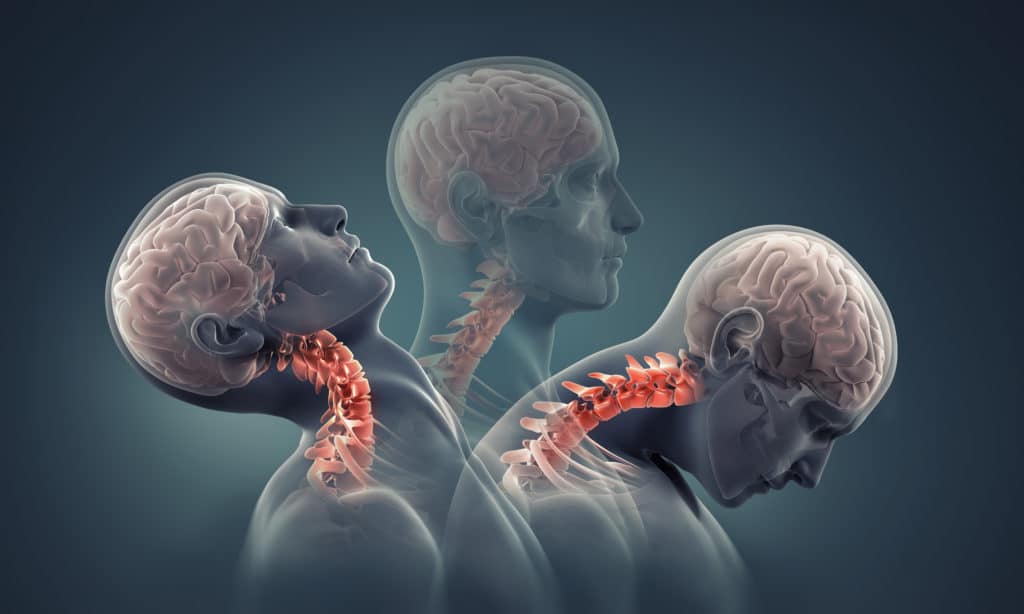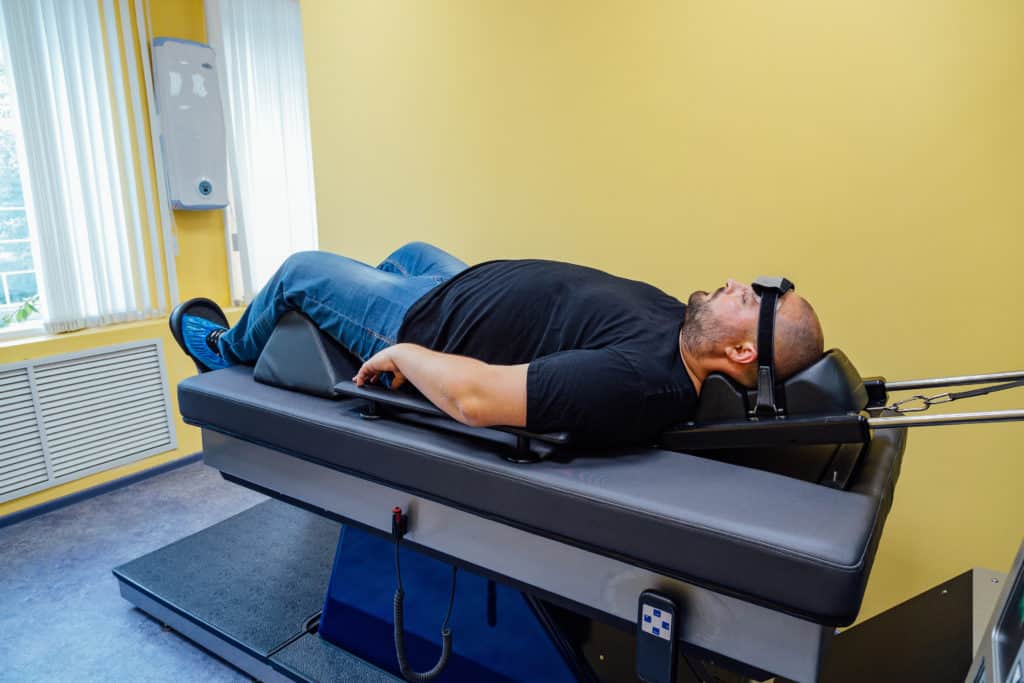Whiplash Treatment in Killeen
Caring for Whiplash injuries in Bell County!
★★★★★ 5-star rated serving the community for over 25 years.
Same-day appointments are available.

Whiplash Treatment
While whiplash is often a mild injury, it can have lasting repercussions on your quality of life if not treated promptly and properly. Chiropractic treatment for whiplash will help address sore, strained, and torn muscles and tendons after an accident.
What is whiplast?
Whiplash is a type of injury that can affect your head, neck, and upper body. When a force of impact jostles you around, it can cause your head and neck to snap backward and forward violently. This sudden movement from a car accident, sports injury, physical abuse, or even certain amusement park rides can cause a whiplash injury. The muscles and tendons in your neck work to support the spine in your neck, maintain your healthy posture, and hold up your head. When a whiplash injury occurs, these muscles and tendons may be stretched beyond their normal limits and lead to strains and tears.

Chiropractic Treatment for Whiplash
There are many treatment options available for a whiplash injury that address your pain symptoms and also help resolve any issues with strength and mobility. You may try at-home remedies for pain relief from whiplash by applying ice and heat to the affected area. Cold compresses help to reduce inflammation in the area and provide pain relief. Warm compresses encourage stiff, sore muscles to relax and promote healthy blood flow. You may also try pain medications, though it is important to understand that pain medications only mask your pain symptoms and do not address the root cause. Chiropractic treatment for whiplash involves an all-natural and drug-free approach to your healing and recovery.

Spinal Manipulation
Spinal manipulation involves identifying misalignments in the spine and resolving them with gentle, therapeutic adjustments. Chiropractic adjustments help address your pain symptoms by realigning your spine and restoring proper functioning. Whiplash can cause the vertebrae in your spine to shift out of healthy alignment. This can also affect the spinal discs that cushion and separate each vertebra. Spinal manipulation can help reduce pressure on nearby nerves by bringing the spine back into healthy alignment and restoring the flow of vital nutrients to the area.

Soft Tissue Therapy
Soft tissue therapy will help to soothe sore, stiff muscles and tendons. A whiplash injury can cause inflammation in your neck and upper back that puts pressure on nerves. Soft tissue therapy works to reduce inflammation and swelling in the area. This type of soft tissue massage gently reduces stress and pressure in the affected area to help improve the healing process. Muscles and tendons that experienced strains and tears due to a whiplash injury benefit greatly from soft tissue therapy. This type of treatment technique also improves flexibility, strength, and mobility in the area.

Spinal Decompression
Spinal decompression can be used in conjunction with other chiropractic treatments to help effectively relieve pain and improve healthy functioning. This type of treatment technique is minimally invasive and a non-surgical approach to address neck pain. Spinal decompression is particularly beneficial when a whiplash injury also includes a disc herniation. When a spinal disc slips or bulges out of place, it can compress nearby nerves and cause pain. Spinal decompression reduces the amount of pressure on the spine and spinal discs by repositioning and elongating the spinal column.

Active Rehab
Chiropractic treatment for whiplash also focuses on active rehabilitation after the injury. Whiplash can negatively impact the range of motion in your neck and make certain movements uncomfortable. Muscles and tendons may also be overstretched and weakened by the whiplash injury. Chiropractors focus on improving strength and mobility in your neck and back so you can regain your full range of motion. Strengthening your neck muscles provides greater support and stability for your spine, head, and neck. Stretches and exercises can help improve your strength and flexibility as you recover from whiplash.
How a Whiplash Injury Happens
The most common cause of whiplash is car accidents. Rear-end collisions and fender-benders are the most common culprits for whiplash injuries because they often take you by surprise. Additionally, while your seat belt protects your upper body from being ejected from the vehicle during an accident, the head and neck are left susceptible to injury. The sudden force of impact between two cars can cause a rapid backward and forward movement of your head and neck that overstretches your neck muscles and tendons. Other causes of whiplash include contact sports like football, motorcycle and cycling accidents, and activities that cause repetitive, jerking movements like horseback riding. A slip and fall or blow to the head can also cause your head to snap forward and backward rapidly.
Signs and Symptoms of Whiplash
It can take hours and even days for signs and symptoms of whiplash to fully appear, especially when whiplash is caused by a car accident or other surprise impact. You may first notice pain and soreness in your neck muscles. Your neck may feel tender to the touch before muscle stiffness sets in. Many people experience difficulty turning their heads in certain directions after a whiplash injury because of muscle stiffness. Tears of the muscles and tendons in the neck can cause excruciating pain, especially with certain movements. Headaches are also common with a whiplash injury because of how the head and neck were jostled around. You may also experience pain and discomfort in your shoulders and upper back. Your shoulders and upper back muscles may also become stiff and sore. Some people also experience shooting, stabbing pains and tingling that radiates into the arms and hands. Dizziness, blurred vision, and fatigue are also signs and symptoms of a whiplash injury.
Diagnosing a Whiplash Injury
Chiropractors diagnose a whiplash injury by performing a physical examination of your head, neck, and upper body. This helps your chiropractor to determine any areas of misalignment in the spine that may be contributing to your pain. A physical exam will also typically include monitoring certain movements, like turning your head from side to side or up and down, and doctors will look for any negative impacts on your range of motion. Your chiropractor will also want to hear about what symptoms you have been experiencing. They will ask you about how the injury occurred and whether the pain you are having is dull, throbbing, stabbing, or aching. It helps to make note of when you first noticed each symptom and whether it has increased in severity. While there isn’t one specific test for diagnosing a whiplash injury, X-rays can be highly beneficial in providing images of the affected area and also helping to rule out other possible diagnoses. Other diagnostic imaging tools can provide your chiropractor with additional images of how soft tissues like muscles and tendons are impacted.
Whiplash Treatment at Affordable Chiropractic
At Killeen Chiropractor Affordable Chiropractic, we offer comprehensive chiropractic therapy that includes spinal decompression and active rehab. We also have on-site X-rays so you can visit one convenient location for your treatment and diagnostic imaging. Our team is able to provide X-ray scans and review them on-site so you can focus on your healing and recovery. Our highly skilled and knowledgeable team of chiropractors offers chiropractic treatment for whiplash that helps manage and relieve your pain and discomfort. We focus on improving your overall health and functioning so you can experience an improved quality of life!
